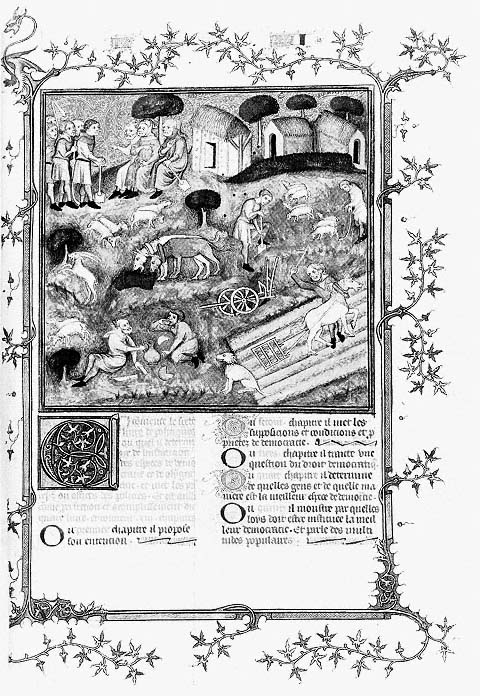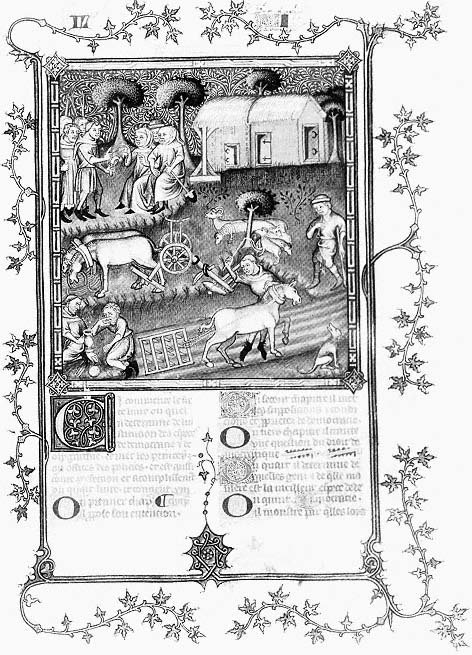The Layout and Format of the Program
In several respects the illustrations for Book VI of the Politiques (Figs. 70 and 71) are unusual. For the first time in the cycle the picture field of a large-scale frontispiece remains undivided and permits the depiction of a continuous landscape. The naturalistic style of these illustrations is a landmark in the development of this genre in late medieval art. In fact, the aesthetic and formal aspects of these images are so engaging that they obscure the textual basis of Oresme's program. Nevertheless, as in previous frontispieces, a close relationship exists among the representational mode, the text, and Oresme's interpretation of its content.
The surprising format and formal qualities of Figures 70 and 71 are related to Aristotle's move from the two previous books, where he treats the typology, destruction, and preservation of actual states, to problems of constructing constitutions in ways that will enable states to survive securely.[1] In Book VI Aristotle discusses the types and suitable structures for oligarchy and democracy, two of the six paradigmatic regimes that he had classified as the vitiated forms of rule by the few and the many. At the beginning of Book VI, however, Aristotle considers combinations of forms of regime, a possibility not previously considered.
While the unbroken picture field in Figures 70 and 71 lends the illustrations a feeling of monumentality, the miniatures are of normal dimensions. Both occupy about two-thirds of the text block. The extraordinary format and formal qualities of these images eclipse the splendid mise-en-page and decorative layout. Free of inscriptions, the undivided rectangular space of the illustrations gives them the appearance of small panel paintings. Except for the foliate, scroll-like pattern of the geometric background at the top, human figures and animals are freely set within a continuous landscape sloping gently upward in a series of three diagonally sectioned planes. Strategically placed trees, animals, and implements lead the eye from the foreground eating and plowing scenes to the grazing horses and shepherd guarding his flock in the middle distance. The third plane contains a group of figures in the upper left, and in the center and upper right planes, thatched buildings nestle among trees.
In Figure 70 (also Pl. 11) the Master of Jean de Sy creates a persuasive naturalistic space. Although figures and objects do not diminish consistently in size as they recede into the distance, the illuminator creates the effect of a harmonious
relationship between figure and natural setting. The unbroken perspective also has the effect of empowering the reader to gain visual control over the subjects portrayed. The men eating in the lower left are set within an ample pocket of space marked off on the top, bottom, and side by plants and a tree; on the right, by a vigilant dog. To the right of this scene, and also on the front plane, the Master of Jean de Sy creates another pocket of space occupied by a steeply raked plot of ground being harrowed by a farmer and his horse. Also convincingly placed in the middle ground are two grazing horses and a flock of sheep, a gamboling goat, and a shepherd. The diminished scale of figures and animals in the middle distance is skillfully executed. Less successful are the spatial relations of the farthest plane, in which the figure groups, trees, and houses seem too large.
The illuminator's judicious use of color also creates the effect of spatial unity. An overall gray-green tone encompasses the entire landscape, with the only exception being the beige and black area of the plowed furrows. On closer inspection this dominant tonality is shaded by stony outcrops painted in a lighter gray. The dark green of the distinctive tree clumps punctuates and marks off planar subdivisions of the picture space, as do the lightly brushed-in, brown forms of vegetation. The same dark green sets off a planted area in front of the three buildings set at sharp angles to one another. Except for the brown of the foremost grazing horse, a contrasting white tonality defines all the animals. White is also used for the walls of the buildings, whereas brown is used for the thatched roofs. A more neutral grayish rose depicts the costumes of all but three of the human figures. The man eating bread, the farmer harrowing the field, and the central figure of the group seated under the tree furnish bright red accents picked up by the background motif and the foliate initial and rubrics below. The Master of Jean de Sy both enlivens and unifies the picture space with this subtle use of color. Although his range is more limited, in Figure 71 the Master of the Coronation Book of Charles V employs similar means. Here a deeper greenish blue delineates the fields and trees of the landscape. Only the gray-brown diagonal swath of the plowed area in the foreground and two gray-blue areas occupied by the grazing horses and the figure groups of the middle and farthest zone relieve the dominant color chord. The grisaille of the figures offers the other major color tonality. Muted tones prevail elsewhere: implements and buildings, yellow-brown for the roofs, whitish brown for the horses, and bluish white for the sheep.
The simplification of color in Figure 71 is echoed in the abbreviated elements of the overall composition. Except for one tree in the middle distance, landscape features are reserved for the farthest zone. Missing also from Figure 71 are several groups of sheep, the gamboling goat, the dismantled cart, and the figure stepping on his spade in the middle distance of Figure 70. Another facet of the reductive character of Figure 71 is the flattening of the spatial recession. The clear definition of the three planes accentuates the sharp, rapid tilt upward. Furthermore, the larger size of the figures and animals decreases the harmonious relationship of men and nature that is a hallmark of Figure 70. Yet in Figure 71 the Coronation Book Master makes positive changes in the composition. For example, the extension of the plowed strip adds coherency to the foreground plane. The same holds true of

Figure 70
Bonne democracie. Les politiques d'Aristote, MS B.

Figure 71
Bonne democracie. Les politiques d'Aristote, MS D.
the relationship among the grazing horses and the cart or plow in the middle ground and the harrowing taking place in the foreground. Two charming touches added by the Coronation Book Master are the upraised head of the dog and the pipe played by the strolling shepherd. Altogether, Figure 71 maintains the convincing representation of figures and animals within a unified landscape setting.
Both images communicate the miniaturists' sympathy for these scenes of rural pursuits. The labors of the peasants and shepherd are portrayed in a positive way. The Master of Jean de Sy seems particularly aware of the plight of agricultural workers, the poor, and politically marginal, as the illustrations for Books IV and VII (Figs. 64 and 74) show. The intensity of expression and the freedom of movement of the men eating and plowing are but two examples of this type of sympathy. Even more marked is the naturalistic observation and representation of animals. Both illuminators effectively convey their different movements and expression. Particularly noteworthy are the absorption of the grazing horses, the patience and suffering of the horses attached to the harrow, the vigilance of the dog, and the sprightliness of the goat. By way of contrast, the men on the upper left of both miniatures seem stiff in pose and gesture. The observations of Schapiro and Panofsky that the lower classes of society and animals are more naturalistically represented than sacred, royal, or aristocratic figures seem to hold true in the context of the Politiques cycles.[2] Panofsky's further observation that the upper classes enjoy the genre rustique as an ironic and parodic commentary on their own pursuits seems appropriate in view of the primary readers of the Politiques .[3] Recent scholarship has raised additional questions about the extent to which this representation of the peasantry expresses the ideology of the ruling classes. These points will be discussed in the concluding section of this chapter.[4]